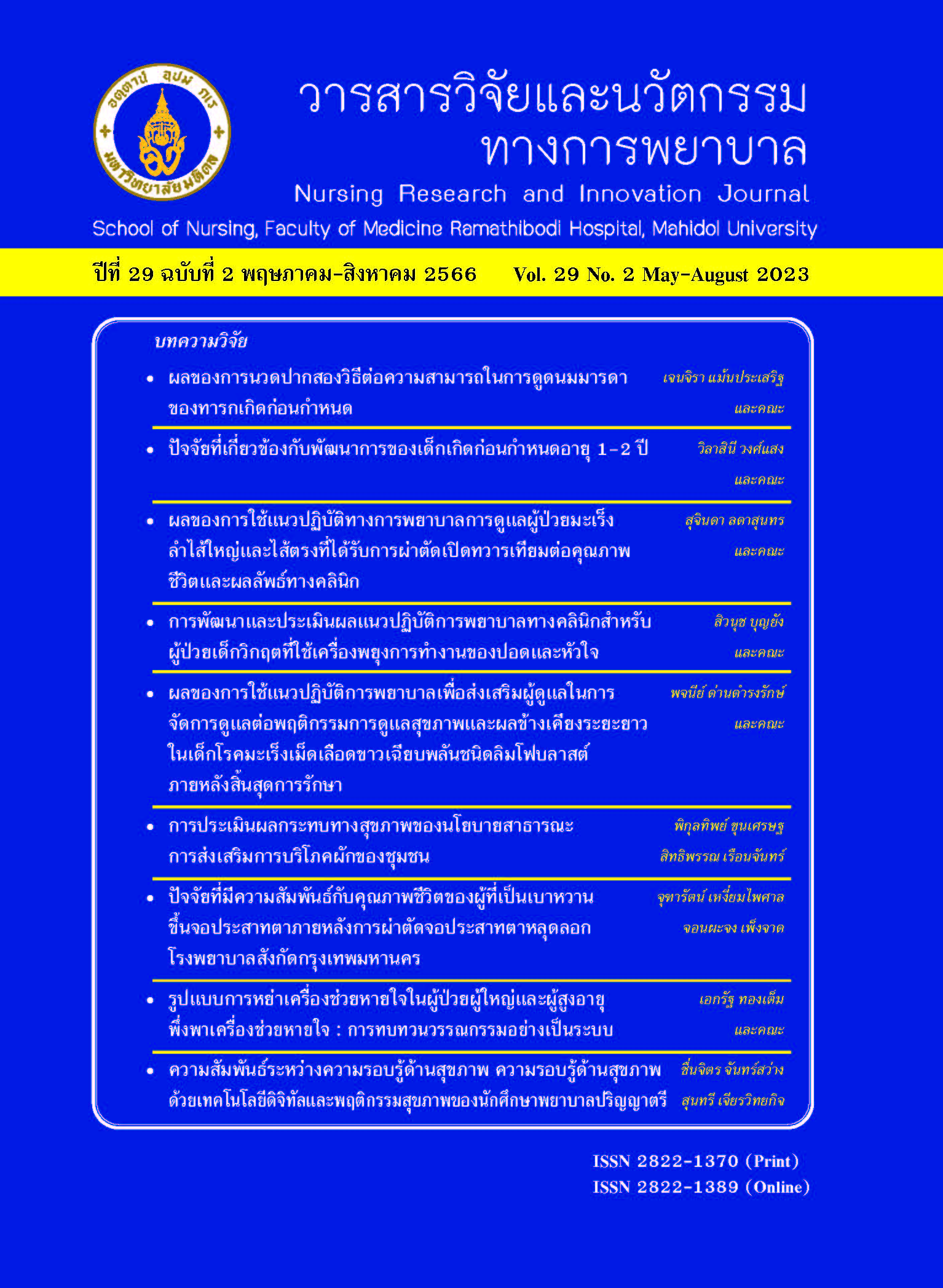The Development and Evaluation of Clinical Nursing Practice Guideline for Critically Ill Children with Extracorporeal Membrane Oxygenation
Main Article Content
Abstract
This study aimed to develop and evaluate clinical nursing practice guidelines for critically ill children receiving Extracorporeal Membrane Oxygenation (ECMO) to avoid complications and enable patients to receive treatment more quickly. Donabedian’s concept of service quality improvement was used and combined with relevant pathophysiology literature to guide the study. The development of evidence-based practice guidelines included 31 research and academic articles. Three stages were created using the following guidelines: 1) ECMO preimplantation nursing care, 2) nursing care while using the ECMO, and 3) post-ECMO nursing care. Three experts evaluated the validity and accuracy of the guidelines, which were then applied to eight critically ill pediatric patients using an ECMO machine. Seventy-five percent of cases required the veno-arterial (VA) ECMO. The average length of stay in the intensive care unit was 11.75 days. The most frequently encountered complication was bleeding. However, when nurses assessed and monitored patients closely, as per clinical nursing practice guidelines, they all were safe. Thrombosis in the pre-membrane circuit was the second complication. When nurses examined the pressure values at the pre-post membrane and checked for clots in the circuit at each turn,
they ensured that the patient was not in danger. From 32 nurses, the probability of following the guidelines was high to extremely high. Overall, nurses reported a high to a very high level of satisfaction with the guideline implementation. This study suggested that ECMO nurses should closely monitor the long-term implications of these clinical nursing practice guidelines for criticallyill pediatric patients receiving ECMO to ensure the feasibility and usefulness of the guidelines for patient safety.
Keywords: Clinical nursing practice guideline, Critical ill children, Extracorporeal membrane oxygenation (ECMO)
Article Details

This work is licensed under a Creative Commons Attribution-NonCommercial-NoDerivatives 4.0 International License.
บทความ ข้อมูล เนื้อหา รูปภาพ ฯลฯ ที่ได้รับการตีพิมพ์ในรามาธิบดีพยาบาลสาร ถือเป็นลิขสิทธิ์ของวารสาร หากบุคคลหรือหน่วยงานใดต้องการนำทั้งหมดหรือส่วนหนึ่งส่วนใดไปเผยแพร่หรือเพื่อกระทำการใด ใด จะต้องได้รับอนุญาตเป็นลายลักษณ์อักษรจากรามาธิบดีพยาบาลสารก่อนเท่านั้น
References
Ruangnapa K. Treatment with extracorporeal membrane oxygenation in pediatric patients with acute respiratory failure. In Bhurayanontachai R, Ruangnapa K, editors.Textbook caring patient use extracorporeal membrane oxygenation. Bangkok: Sahamit Pattana Printing; 2018.p. 225-40. (in Thai)
Schwartz SM, Schmidt A. Medical and nursing care of the child on mechanical circulatory support. Pediatr Crit Care Med. 2013;14(5):43-50.
Lertbunrian R, Kositset A. Use extracorporeal membrane oxygenation (ECMO). In Kositset A, Preutthipan A,Limrangsikul A, Khogkhatithum C, Pandee U, Lertbunrian R, editors. Pediatric critical care. Bangkok: Wandee Printing; 2013. p. 661-70. (in Thai)
Connor ON, Smith JR. An innovative ECMO staffing model to reduce harm. J Perinat Neonatal Nurs.2018;32(3):204-5.
Kosaiyawat S. The national children’s day: development and importance to human resource development. Journal of Education and Social Development. 2008;4:1-17.(in Thai)
Cherian S. Trends in extracorporeal membrane oxygenation (ECMO) nursing. 2015 [cited 2019 May 6]. Available from: https://www.researchgate.net/publication/ 314216150_Trends_in_Extracorporeal_membrane_oxygenation ECMO_ nursing.
Mossadegh C, Combes A. (Eds.). Nursing care and ECMO (13th ed). Cham: Springer; 2017.
Eden A, Purkiss C, Cork G, Baddeley A, Morri, K, Carey L, et al. In-patient physiotherapy for adults on venovenous extracorporeal membrane oxygenation -United Kingdom ECMO physiotherapy network: a consensus agreement for best practice. J Intensive Care Soc.
;18(3):212-20.
Calhoun, A. ECMO: Nursing care of adult patients on ECMO. Crit Care Nurs Q. 2018;41(4):394-8.
Supachutikul A. Patient safety goals: SIMPLE.Accreditation is an Educational Process. Nonthaburi:Famous and successful ; 2018. (in Thai)
Pornsirirat T, Thongyu S. Nursing care of patients with acute respiratory failure using extracorporeal membrane oxygenation. Siriraj Medical Bulletin. 2016;9:44-50.(in Thai)
Zangrillo A, Landoni G, Biondi-Zoccai G, Greco M,Greco T, Frati G, et al. A meta-analysis of complications and mortality of extracorporeal membrane oxygenation.Crit Care Resusc. 2013;15(3):172-8.
Courtwright SE, Mastro KA, Preuster C, Dardashti N,McGill S, Madelon M, Johnson D. Reducing hospitalacquired pressure ulcers using bundle methodology in pediatric and neonatal patients receiving extracorporeal membrane oxygenation therapy: An integrative review and call to action. J Spec Pediatr Nurs. 2017;22(4):1-14.
Biffi S, Di Bella S, Scaravilli V, Peri AM, Grasselli G,Alagna L, et al. Infections during extracorporeal membrane oxygenation: epidemiology, risk factors, pathogenesis and prevention.Int J Antimicrob Agents. 2017;50(1):9-16.
Schwartz SM, Schmidt A. Medical and nursing care of the child on mechanical circulatory support. Pediatr Crit Care Med. 2013;14(5):43-50.
Carpenter JL, Yu YR, Cass DL, Olutoye OO, Thomas JA, Burgman C, et al. Use of venovenous ECMO for neonatal and pediatric ECMO: a decade of experience at a tertiary children’s hospital. Pediatr Surg Int. 2018;34(3):263-8.
Hanson SJ, Jaber B, Bembea MM, Loftis LL, Spinella PC, Zhang L, et al. Venovenous versus venoarterial extracorporeal membranous oxygenation in inotrope dependent pediatric patients with respiratory failure.ASAIO J. 2021;67(4):457-62.
Fernando SM, Qureshi D, Tanuseputro P, Dhanani S,Guerguerian AM, Shemie SD, et al. Long-term survival and costs following extracorporeal membrane oxygenation in critically ill children -a population-based cohort study.Crit Care. 2020;24(1):1-11.
Alshammari MA, Vellolikalam C, Alfeeli S. Nurses’perception of their role in extracorporeal membrane oxygenation care: a qualitative assessment. Nurs Crit Care.2020;27(2):251–7.
Botsch A, Protain E, Smith AR, Szilagyi R. Nursing implications in the ECMO patient. 2019 [cited 2021 May28]. Available from: http://dx.doi.org/10.5772/intechopen.85982.
Cherian S.Trends in extracorporeal membrane oxygenation (ECMO) nursing. 2015 [cited 2019 May 6]. Available
from: https://www.researchgate.net/publication/ 314216150_Trends_in_Extracorporeal_membrane_oxygenation ECMO_ nursing.
Liao MT, Tsai IJ, Lin FH, Tseng LJ, Huang SC, Chen YS, et al. Risk factors for in-hospital mortality and acute kidney injury in neonatal-pediatric patients receiving extracorporeal membrane oxygenation. J Formos Med Assoc. 2021;120(9):1758-67.
Bergeron A, Holifield L. Extracorporeal membrane oxygenation: The nurse’s role in patient care nursing. Nurs Crit Care. 2020;15(3):6-14.
Hamed A, Alinier G, Hassan IF. The ECMO specialist’s role in troubleshooting ECMO emergencies. Egypt J Crit Care Med. 2018;6(3):91–3.
Fouilloux V, Gran C, Guervilly C, Breaud J, Louali FE,Rostini P. Impact of education and training course for ECMO patients based on high-fidelity simulation: a pilot study dedicated to ICU nurses. Perfusion. 2019;34(1):29–34.


